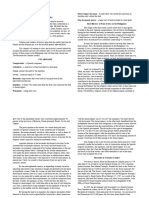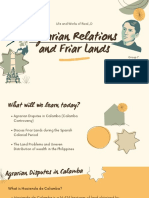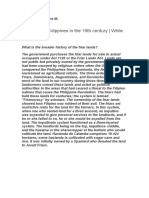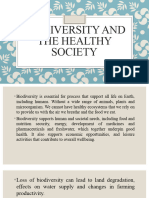Lesson05 MIDTERM-2
Lesson05 MIDTERM-2
Uploaded by
Janna Hazel Villarino VillanuevaCopyright:
Available Formats
Lesson05 MIDTERM-2
Lesson05 MIDTERM-2
Uploaded by
Janna Hazel Villarino VillanuevaOriginal Title
Copyright
Available Formats
Share this document
Did you find this document useful?
Is this content inappropriate?
Copyright:
Available Formats
Lesson05 MIDTERM-2
Lesson05 MIDTERM-2
Uploaded by
Janna Hazel Villarino VillanuevaCopyright:
Available Formats
1
Lesson 5. Agrarian Relations and the Friar Lands
This lesson provides a short history of the dynamics of landownership in the Philippines during Rizal’s
time. It discusses the hacienda system in connection with the existence of friar lands. Specifically, it mentions
conflicts arising from the hacienda system and shows their impacts on Philippine society and on the family of
Rizal as inquilinos.
Lesson Objectives: Vocabulary
At the end of this lesson, you will be able to: Conquistador – a Spanish conqueror.
Caballeria – a small tract of land included in a land grant.
Identify the different issues on land ownership Sitio de Ganado Mayor – a large tract of land included in
from pre-colonial to colonial period; a land grant.
Hacienda – large estates that were used for raising
Explain how the Hacienda de Calamba issue serves livestock and agricultural production.
as an exemplary illustration of agrarian conflicts in Inquilino – a tenant who rented land from the friars and
the late 19th century; and subleased land to sharecroppers.
Sharecropper – an individual who rented the land from an
Analyse how the hacienda system impacts the inquilino and worked the land.
Philippines.
Getting Started:
In 1891, Jose Rizal was in Hongkong when he received distressing news about his family who were, at
the same time, involved in a court case concerning the Hacienda de Calamba. He heard that the Spanish
authorities were summoning his mother, Doña Teodora, and two younger sisters, Josefa and Trinidad, for
further investigation. In a show of support, he wrote to his family, “I am following your cavalry step by step, I
am doing all I can… Patience, a little patience. Courage!”
Scholars and students of history agree that the conflict between his family and the Dominicans over the
hacienda greatly affected Rizal.
History of the Friar Lands
The existence of friar lands in the Philippines can be traced back to the early Spanish colonial period
when Spanish conquistadors were awarded lands in the form of haciendas for their loyalty to the Spanish
Learning Module on The Life and Works of Jose Rizal
2
crown. Approximately 120 Spaniards were granted either large tracts of land called sitio de ganado mayor or
smaller tracts of land called caballerias.
However, the hacienderos, those who owned the haciendas, failed to develop their lands. One reason is
that the Spaniards were not expected to permanently stay in the Philippines. Many of them returned to Spain
once they were done serving in the country. Second reason is that the livestock market during this time was still
small. Third reason is that the Galleon Trade based in Manila, appealed more to the Spaniards because it
offered better economic opportunities.
The Spanish friars were able to acquire land through whatever means available to them. According to
the sources, lands were donated to the friars in exchange for spiritual favors. Many Filipinos believed that the
friars had no titles to the lands they owned because they acquired them through usurpation and other dubious
means.
When the exports of agricultural crops started to blossom in the 18 th century, the inquilinato system was
put into place. In this system, one who rented land for a fixed annual amount. an inquilino, was expected to
give personal services to the landlords. If he or she failed to do so, he or she would be expelled from the land.
The inquilinos could also leased the land they were renting from the landlord to a kasama or sharecropper who
would then be responsible for cultivating the land. The inquilinato system functioned as a three-layered system
with the landlords on top, the inquilinos in the middle, and the kasamas at the bottom.
Hacienda de Calamba Dispute
The Hacienda de Calamba was originally owned by a Spaniard, Don Manuel Jauregui, who donated
the land to Jesuit friars to allow him to permanently stay in the Jesuit monastery. However, since the Jesuits
were expelled from the Philippines, the hacienda went to the possession of the Spanish colonial government. In
1803, the land was sold to Don Clemente de Azansa. After his death, it was eventually sold to the Dominicans
who claimed the ownership of the hacienda until the late 19th century.
Rizal’s family house became one of the principal inquilinos of the hacienda. They rented one of the
largest leased parcels of land measuring approximately 380 hectares. The main crop was sugarcane since it was
the most in-demand in the world market then. The Rizal family got their income mainly from the land they
Learning Module on The Life and Works of Jose Rizal
3
rented. However, when conflicts on land ownership in the hacienda arose in 1883, the family evidently
suffered.
Summary
This lesson showed the historical context behind this incident that played a pivotal role in Rizal’s life.
It provided a brief history of friar states in the Philippines and looked closely into the Hacienda de
Calamba conflict.
References:
Obias, R., Mallari, A. & Estella, J. (2018), The Life and Works of Jose Rizal, C& E Publishing, Inc.,
Clemente, J. & Cruz, G. (2019), The Life and Works of Rizal Outcome-Based Module, C& E Publishing, Inc.,
Crudo, E., Guiwa, H. & Pawilen, R. (2019), A Course Module for The Life, Works, and Writings of Jose Rizal,
Rex Bookstore, Inc.,
Learning Module on The Life and Works of Jose Rizal
You might also like
- Church Lands in The Agrarian History in Tagalog RegionDocument2 pagesChurch Lands in The Agrarian History in Tagalog RegionЅєди Диԁяєш Вцвди Ҩяцтдѕ100% (2)
- Chapter 6 Agrarian DisputeDocument9 pagesChapter 6 Agrarian DisputeJuMakMat Mac100% (3)
- Agrarian DisputesDocument30 pagesAgrarian DisputesJen Comia100% (2)
- Module 7 Landownership and The Rise of Friar LandsDocument5 pagesModule 7 Landownership and The Rise of Friar LandsClaire Evann Villena Ebora100% (1)
- Agrarian Relations and Friar Lands: 19th Century Philippines As Rizal's ContextDocument29 pagesAgrarian Relations and Friar Lands: 19th Century Philippines As Rizal's ContextEunice Ortile100% (1)
- Agrarian Relations and Friar LandsDocument14 pagesAgrarian Relations and Friar LandsPrince DetallaNo ratings yet
- Agrarian Relations and Friar LandsDocument13 pagesAgrarian Relations and Friar LandsJessica PenaflorNo ratings yet
- Agrarian DisputesDocument13 pagesAgrarian Disputesshannon gwapaNo ratings yet
- Final Rizal Module 2020Document38 pagesFinal Rizal Module 2020Kent Ian ClaridadNo ratings yet
- Week 7-Agrarian DisputesDocument5 pagesWeek 7-Agrarian DisputesEstefanie GalveNo ratings yet
- RizalDocument4 pagesRizalChadBeancoL.GabejanNo ratings yet
- Module 6 Agrarian DisputesDocument3 pagesModule 6 Agrarian DisputesTrisha Pauline PangilinanNo ratings yet
- Chapter 6 Agrarian DisputesDocument24 pagesChapter 6 Agrarian Disputesjep2003maigueNo ratings yet
- 3.2 Agrarian Disputes - SOCSC 005-ARCH42S6 - Life and Works of RizalDocument5 pages3.2 Agrarian Disputes - SOCSC 005-ARCH42S6 - Life and Works of RizalAngelo OñedoNo ratings yet
- Agragian DisputesDocument4 pagesAgragian DisputesCharlotte RiveraNo ratings yet
- Life and Works of RizalDocument8 pagesLife and Works of RizalBinalo, Alyson T. - BSRT 2D100% (1)
- 3.2 Agrarian DisputesDocument5 pages3.2 Agrarian DisputesSalarda KesterNo ratings yet
- AgrarianDocument4 pagesAgrarianHafsah A. DisomangcopNo ratings yet
- Agrarian DisputesDocument3 pagesAgrarian DisputesRheny BondocNo ratings yet
- Chapter 6 - 11 (Rizal)Document15 pagesChapter 6 - 11 (Rizal)Erwin Manongol YsugNo ratings yet
- Development Created Them? at Least 5 Sentences (10 PTS) : A. Who Were The Ilustrados and How Did Various 19th CenturyDocument3 pagesDevelopment Created Them? at Least 5 Sentences (10 PTS) : A. Who Were The Ilustrados and How Did Various 19th CenturyLouise BattadNo ratings yet
- Vocabulary Words: Life, Works & Writings of RizalDocument2 pagesVocabulary Words: Life, Works & Writings of RizalAshley jay Palang100% (1)
- Synthesize What You Have Learned About The Formation of The Haciendas During The Spanish Colonization in The PhilippinesDocument3 pagesSynthesize What You Have Learned About The Formation of The Haciendas During The Spanish Colonization in The PhilippinesIce Voltaire B. GuiangNo ratings yet
- Lesson 3 Agrarian Relations and Friar Lands FinalDocument30 pagesLesson 3 Agrarian Relations and Friar Lands Finalfranciscoyen575No ratings yet
- Chapter 6Document7 pagesChapter 6Jade Harris Colorje100% (2)
- Agrarian LandsDocument61 pagesAgrarian LandsLizza PerezNo ratings yet
- Rizal's Life Chapter 4 Part 2Document10 pagesRizal's Life Chapter 4 Part 2Myra Kristel Khay MijaresNo ratings yet
- Agrarian Relations and Friar LandsDocument14 pagesAgrarian Relations and Friar LandsBebeybaebay 0320kNo ratings yet
- Agrarian Relations and The Friar Lands (Short Quiz)Document1 pageAgrarian Relations and The Friar Lands (Short Quiz)Barbie BleuNo ratings yet
- Reporters: Navarro, Angelica Paola S. Noga, Monique C. Nosares, Shaina M. Perez, Joshua B. Agrarian Relations and Friar LandsDocument6 pagesReporters: Navarro, Angelica Paola S. Noga, Monique C. Nosares, Shaina M. Perez, Joshua B. Agrarian Relations and Friar LandsAngelica NavarroNo ratings yet
- Agrarian DisputesDocument6 pagesAgrarian DisputesSheena Pearl Alinsangan50% (4)
- Mahabang LectureDocument32 pagesMahabang LectureDaphne Joyce NocilladoNo ratings yet
- Agrarian Relations and Friar LandsDocument24 pagesAgrarian Relations and Friar LandsAngelica NavarroNo ratings yet
- Agrarian Relations and Friar LandsDocument2 pagesAgrarian Relations and Friar LandsYll AsheilemaNo ratings yet
- The Philippines in The 19th CenturyDocument2 pagesThe Philippines in The 19th CenturyIrene M. Macapagong100% (1)
- G2-Haciendas Owned by The Friars and Agrarian RelationsDocument28 pagesG2-Haciendas Owned by The Friars and Agrarian Relationselaineshanice0No ratings yet
- Week 4 LectureDocument26 pagesWeek 4 LectureBossNateNo ratings yet
- Agrarian Reforms and Friar LandsDocument18 pagesAgrarian Reforms and Friar LandsMarvin AlegadoNo ratings yet
- LOTIVIO - Rizal 7.1 and 7.2Document2 pagesLOTIVIO - Rizal 7.1 and 7.2LOTIVIO VIKTORIANo ratings yet
- Rizal On Agrarian IssuesDocument10 pagesRizal On Agrarian Issuesmarian reyes50% (2)
- LWR.M.Chapter.6.The Agrarian DisputeDocument2 pagesLWR.M.Chapter.6.The Agrarian DisputeJoeri L. Cabafin Jr.No ratings yet
- RizalDocument16 pagesRizalPatricia Nicole BolivarNo ratings yet
- Print Only Chapter 4-The Hacienda de Calamba Agrarian ProblemDocument62 pagesPrint Only Chapter 4-The Hacienda de Calamba Agrarian ProblemJohn Mark SanchezNo ratings yet
- Agrarian Relations and Friar Lands: Monique - Red Shaina - Orange Joshua - Blue Angelica - GreenDocument15 pagesAgrarian Relations and Friar Lands: Monique - Red Shaina - Orange Joshua - Blue Angelica - GreenAngelica NavarroNo ratings yet
- 19th Century Philippines As Rizal's Context: Agrarian Relations and The Friar LandsDocument38 pages19th Century Philippines As Rizal's Context: Agrarian Relations and The Friar LandsVince Martin OrozcoNo ratings yet
- Land Ownership and The Rise of Friar LandsDocument13 pagesLand Ownership and The Rise of Friar LandsUnknown GuyNo ratings yet
- Last Midterm Content PaperDocument10 pagesLast Midterm Content PaperCyd Jesper DanguilanNo ratings yet
- Instructions: Write A 500-Word Essay On Your View On The History of Friar Lands and TheDocument3 pagesInstructions: Write A 500-Word Essay On Your View On The History of Friar Lands and TheFernan Erick LopezNo ratings yet
- Agrarian Reform in The PhilippinesDocument9 pagesAgrarian Reform in The PhilippinesKyla RestriveraNo ratings yet
- Group 6 Batch 2 BSTM101 TP Pre FinalDocument66 pagesGroup 6 Batch 2 BSTM101 TP Pre FinalAngelica MotayNo ratings yet
- Rizal SoftDocument3 pagesRizal SoftCanon Rock JavinessNo ratings yet
- Land and Agrarian Reform in The PhilippinesDocument5 pagesLand and Agrarian Reform in The PhilippinesJerwin SamsonNo ratings yet
- Reviewer RizalDocument6 pagesReviewer Rizalestrellakevin.30No ratings yet
- Gec2 Repoting WedDocument4 pagesGec2 Repoting WedMike Cadag GulayNo ratings yet
- Agrarian Relations and The Friar LandsDocument2 pagesAgrarian Relations and The Friar LandsKeena SalinasNo ratings yet
- Agrarian Reform Faqs (Frequently Asked Questions) : I. Pre-Colonial Era Ii. Spanish EraDocument13 pagesAgrarian Reform Faqs (Frequently Asked Questions) : I. Pre-Colonial Era Ii. Spanish EraNicole CuriosoNo ratings yet
- Midterm-Rizal-Handouts First Sem 2023 TipqcDocument34 pagesMidterm-Rizal-Handouts First Sem 2023 Tipqcallengonzales01234No ratings yet
- Hacienda de Calamba BackgroundDocument14 pagesHacienda de Calamba BackgroundMary Jane MasulaNo ratings yet
- The Encomienda in New Spain: The Beginning of Spanish MexicoFrom EverandThe Encomienda in New Spain: The Beginning of Spanish MexicoRating: 5 out of 5 stars5/5 (1)
- Rizal PrelimsDocument52 pagesRizal PrelimsJanna Hazel Villarino VillanuevaNo ratings yet
- CCC Research Concept PaperDocument3 pagesCCC Research Concept PaperJanna Hazel Villarino VillanuevaNo ratings yet
- Lesson03 MIDTDocument8 pagesLesson03 MIDTJanna Hazel Villarino VillanuevaNo ratings yet
- Chapt. 2 - The Professional StandardsDocument31 pagesChapt. 2 - The Professional StandardsJanna Hazel Villarino VillanuevaNo ratings yet
- Lesson 02Document5 pagesLesson 02Janna Hazel Villarino VillanuevaNo ratings yet
- Rizal Module1 Lesson1Document27 pagesRizal Module1 Lesson1Janna Hazel Villarino VillanuevaNo ratings yet
- Chapter3 MasterdataanddocumenthandlingDocument8 pagesChapter3 MasterdataanddocumenthandlingJanna Hazel Villarino VillanuevaNo ratings yet
- Global InnovationDocument20 pagesGlobal InnovationJanna Hazel Villarino VillanuevaNo ratings yet
- AuditingTheory Chapter1Document19 pagesAuditingTheory Chapter1Janna Hazel Villarino VillanuevaNo ratings yet
- Evaluation of Farmers Resilience Against SocioecoDocument13 pagesEvaluation of Farmers Resilience Against Socioecomorteza imaniNo ratings yet
- Introduction To Agricultural RevolutionDocument3 pagesIntroduction To Agricultural RevolutionSarah JacksonNo ratings yet
- Lagos Spinach PDFDocument8 pagesLagos Spinach PDFObayuwana Osamede EdmondNo ratings yet
- Business Plan-Stone QuarryingDocument46 pagesBusiness Plan-Stone QuarryingAbiy SeyoumNo ratings yet
- VERMIFILTREDocument12 pagesVERMIFILTREpiyush chaudharyNo ratings yet
- FSQC Unit 1Document12 pagesFSQC Unit 1nousheenirfanasNo ratings yet
- "National Bank For Agriculture and Rural Development & Gujarat Agro Industries Corporation " Submitted ToDocument18 pages"National Bank For Agriculture and Rural Development & Gujarat Agro Industries Corporation " Submitted ToParthMairNo ratings yet
- June 17, 2010Document24 pagesJune 17, 2010PulaskiNewsNo ratings yet
- Biodiversity and The Healthy SocietyDocument39 pagesBiodiversity and The Healthy SocietyRheajen Mae RebamonteNo ratings yet
- MAU TASK 1 by SimonDocument64 pagesMAU TASK 1 by SimonĐào Thu ThuỷNo ratings yet
- Seeds of SuicideDocument159 pagesSeeds of Suicideramkumaran100% (2)
- Turfing Services BizHouse - UkDocument2 pagesTurfing Services BizHouse - UkAlex BekeNo ratings yet
- IESL PaperIWMI SMPDocument14 pagesIESL PaperIWMI SMPthamiradNo ratings yet
- Marking Scheme Geography Final March 2024Document10 pagesMarking Scheme Geography Final March 2024zrandhawa1620No ratings yet
- Leaf NitrateDocument66 pagesLeaf NitrateBrandi WallaceNo ratings yet
- Effect of Harvesting Time On Yield, Composition and Forage Quality of Some Forage Sorghum CultivarsDocument8 pagesEffect of Harvesting Time On Yield, Composition and Forage Quality of Some Forage Sorghum Cultivarsarid132No ratings yet
- Guidelines of SMAM1Document55 pagesGuidelines of SMAM1Subhasis MishraNo ratings yet
- Gender in The Csa Discourse: Making The Case For Gender-SmartnessDocument23 pagesGender in The Csa Discourse: Making The Case For Gender-SmartnessUNDP World Centre for Sustainable DevelopmentNo ratings yet
- Oppong-Sekyere Et Al (2011) - Characterization of Okra (Abelmoschus Spp. L.)Document12 pagesOppong-Sekyere Et Al (2011) - Characterization of Okra (Abelmoschus Spp. L.)Eric BrenNo ratings yet
- Areca Report KavyaDocument47 pagesAreca Report KavyaMadhu100% (2)
- Organic VegetableDocument45 pagesOrganic VegetablevijjumandulaNo ratings yet
- Uganda Agriculture Sector Public Expenditure ReviewDocument147 pagesUganda Agriculture Sector Public Expenditure ReviewThe Independent MagazineNo ratings yet
- Mizoram Industrial Policy 2021 DraftDocument33 pagesMizoram Industrial Policy 2021 Drafteoidw22No ratings yet
- Reading Passage 5Document5 pagesReading Passage 5htetmyatag 2014No ratings yet
- January 22-28, 2012Document10 pagesJanuary 22-28, 2012Bikol ReporterNo ratings yet
- FIN 405 RezaulDocument9 pagesFIN 405 RezaulAl MamunNo ratings yet
- Unit Development Reporting: StructureDocument16 pagesUnit Development Reporting: StructureSuniti AroraNo ratings yet
- The Dawn of A Plant Based AgeDocument52 pagesThe Dawn of A Plant Based AgePune Vegans100% (1)
- Sustainable DevelopmentDocument15 pagesSustainable Developmentsaeedsalehi100% (3)
- Baseline Survey On Competition and Markets in Ethiopia PDFDocument112 pagesBaseline Survey On Competition and Markets in Ethiopia PDFPrasanna KumarNo ratings yet


































































































